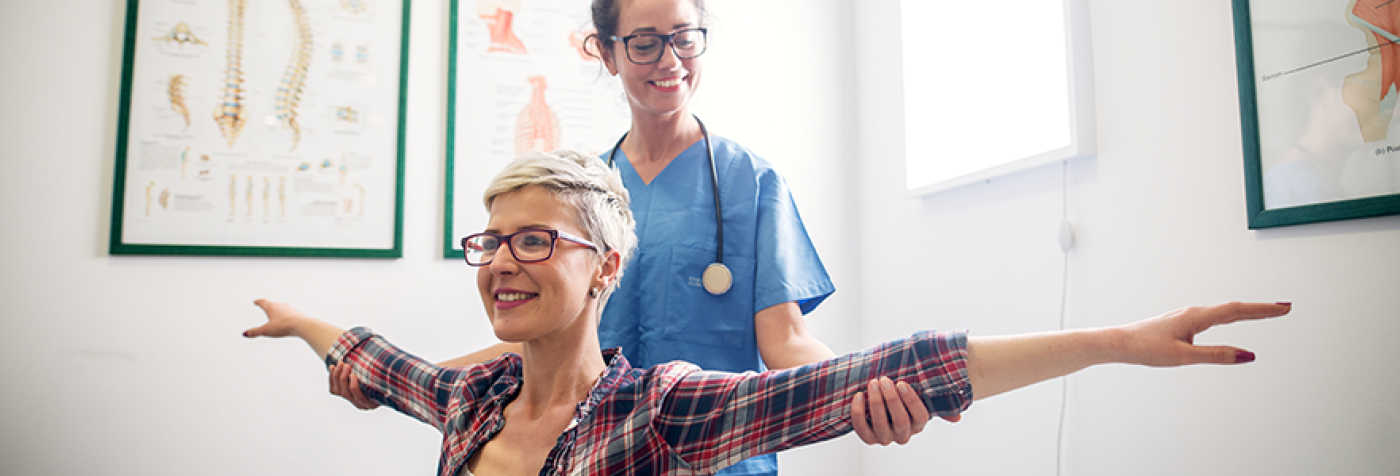Deformities of the spine

Disorders in which the spine becomes curved or out of place can develop at any age and stem from a number of causes, including injury, developmental issues, degenerative diseases, genetics, poor posture and no known cause at all.
Types
- Kyphosis causes the back to appear rounded.
- Lordosis (also known as “swayback”) results in the lumbar spine curving inward.
- Scoliosis causes the spine to curve sideways and appear C-shaped or S-shaped.
- Spondylolisthesis involves a fractured vertebra that slips out of place and onto the vertebra below it.
Symptoms
Kyphosis:
- Back stiffness and/or pain
- Loss of feeling, fragility or tingling sensation in the legs
- Rounded or humped shoulders
- Spinal tenderness
- Tightly wound hamstrings
- Tiredness
Lordosis:
- Back pain
Scoliosis:
- Asymmetrical or rounded shoulders
- Eventual back pain
- Head that appears off-center
- Tiredness
Spondylolisthesis:
- Back pain that may spread to the hamstring muscles and/or buttocks
- Problems with walking and/or standing
- Stiffness in the back
- Tightly wound hamstrings
Prevention
- Kyphosis may be prevented through proper posture, the incorporation of regular activity that strengthens the back and keeps it flexible, and by avoiding carrying objects, such as school bags, that place unnecessary pressure on the back.
- While there are currently no guidelines to prevent lordosis, maintaining a healthy weight and proper posture may reduce patients’ risk.
- Scoliosis can usually not be prevented.
- Patients may be able to reduce their risk of spondylolisthesis by quickly seeking treatment for spinal injuries and by avoiding activities that repeatedly place stress on the lower back.
Risk factors
Kyphosis:
- Abnormally developed spine
- Abnormally shaped vertebrae
- Older age
- Poor posture
- Previous spinal injuries
Lordosis:
- Achondroplasia (a genetic disorder that affects cartilage growth)
- A thoracic spine that curves too much outwards
- A spine that develops abnormally
- Intervertebral disc issues
- Obesity
- Osteoporosis
- Poor posture
- Prior back surgery
- Spondylolisthesis
Scoliosis:
- A family history of of scoliosis
- Age (most commonly develops in children and younger teenagers)
Spondylolisthesis:
- Age and activity (common in children and younger teenagers who are involved in activities that place stress on the back)
- Being female
- Diabetes
- Pregnancy
- Previous spinal injury that is left untreated or does not heal properly
- Osteoarthritis
Diagnosis
- Review of medical records and physical exam. Providers will ask patients about their health and symptoms and conduct a thorough examination.
- Imaging. X-rays are the most common imaging test administered for deformities of the spine. However, MRI and CT scans may also be recommended depending on the type of spine disorder and the symptoms.
- Additional tests. If patients’ spine disorders affect other aspects of their health, additional tests may be recommended.
Treatment
- No treatment. Depending on the patient’s age and the severity of the deformity, providers may recommend close observation alone.
- Medications or injections. Nonsteroidal anti-inflammatory medications can provide temporary relief from back pain. Steroidal injections may be administered in certain cases, as well.
- Physical therapy. Physical therapy can help patients learn to strengthen their backs, improve their posture and flexibility, relieve pain, increase their range of motion and stretch tight muscles.
- Use of a brace. Bracing can help relieve pain by limiting motion, protect fractures from reinjury as patients heal (as is the case with spondylolisthesis) and help some disorders from worsening as younger patients grow.
- Surgery. If symptoms worsen or cause neurological issues and more conservative treatments have failed, surgery may be advised.
Follow-up care
- Continued observation by providers is essential to the long-term outcomes of patients with deformities of the spine.
